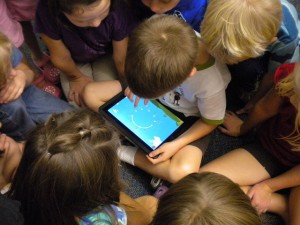Part 4 of MindShift’s Guide to Games and Learning.
 For years, most people thought that video games were like candy: mostly bad, tempting to children, but okay in moderation. Now we understand that they can have more “nutritional” value than our parents ever imagined.
For years, most people thought that video games were like candy: mostly bad, tempting to children, but okay in moderation. Now we understand that they can have more “nutritional” value than our parents ever imagined.
My brothers and I played Space Invaders and Pac Man, Asteroids and Breakout. We pulled the plastic casing off the Atari joystick and stuck the accordioned bottom end to our foreheads like a suction cup. These were still the early days of interactive home computing and because game consoles were so unfamiliar, the adults were afraid. Surely, they assumed, staring at a box of glowing light while pressing buttons in response to electronic triggers would cause some invisible neural damage.
Kids played video games for hours. They wiggled joysticks and maneuvered “paddles” until they discovered the game’s patterns. They talked about the games with their friends. They shared tips and tricks. Even if they were learning together, and if the arcade was always a kind of educational community, what exactly were they learning? Clearly, not the things that mattered. All learning is not good learning. Something had to be done.

Along came Oregon Trail, Reader Rabbit, Math Blaster, and others. Gamification was not yet a household word. Back then, folks “school-ified” video games. The shoot-em up alien attack narratives were replaced with educational curriculum: facts about letters, numbers, history, science. Each correct solution launched a missile at your enemy. If kids were going to memorize all the details of a video game, why not construct those details so that they align with classroom content? It made sense. And it worked. Many of us learned touch typing from Mario and geography from Carmen Sandiego.
Clearly, the world has changed considerably since then. Interacting with machines is commonplace. It’s normal to respond to screen-based electronic stimuli. Work almost always involves some interaction with digital platforms. Maybe this is why video games no longer inspire the same kind of anxiety and terror from parents and caregivers as they once did. In fact, we now know that games can teach much more than just content. There are social, emotional, and meta-cognitive benefits.
In 2013, the American Psychological Association published a study that identified some of the benefits of gaming, and the results were surprising. For example, in controlled tests, kids who played first-person shooters showed “faster and more accurate attention allocation, higher spatial resolution in visual processing, and enhanced mental rotation abilities.” This likely has very little to do with the violent narrative and a lot to do with repetitive execution of reflex-based actions. Essentially, first person shooters are intricate 3D virtual simulations of the carnival classic “whack-a-mole.” Players need to react fast. This is why kids who play a lot of games seem to show “measurable changes in neural processing and efficiency” and a positive increase in creativity. Players practice quick thinking and hurried response.
Of course, neural advantages like these are vague and invisible. Research that assumes a biologically deterministic view of humanity should be questioned. When we imagine ourselves as cellular organisms first and only second as uniquely human, we equate ourselves with amoebas, insects, and animals. This theoretical approach implicitly assumes that our development and actions are determined by electrochemical and biological impulses alone. Instinct reigns. The classic conception that distinguishes humans as “moral” animals is rendered obsolete. These neuroscientific discoveries may be accurate, but when it comes to learning, is this approach useful? After all, our intention is not husbandry in a petri dish. Instead, we aim to nurture human citizens that contribute to an ethical civilization.
We want our children to develop strong meta-cognitive skills. We want students to become critical thinkers that are motivated to make a difference in the world. When it comes to motivation, look to the work of Carol Dweck, Stanford professor who writes about motivation and social development. She makes a distinction between an entity theory of intelligence and an incremental theory of intelligence. When kids develop an entity theory of intelligence, they believe they have innate, fixed traits. They’re praised for being smart, or being good at math. It has a negative impact on long term attitudes. When kids develop an incremental theory of intelligence, on the other hand, they understand that they have certain skills. They are praised for their effort: “you worked so hard on that problem, you solved that puzzle.” They have a growth mindset.
Video games nurture an incremental understanding of intelligence. Because players are rewarded for one task at a time — for overcoming one obstacle after another — they learn to understand learning and accomplishment iteratively. For example, each track in Nintendo’s classic game Mario Kart has its own particular challenges. Each time a player drives it he or she addresses the weaknesses of the previous attempt. The player iterates performance incrementally, addressing shortcomings and adjusting accordingly. He or she understands that mastering one course doesn’t necessarily equate to mastery of the next. A new learning process begins at the conclusion of the previous one.
Games designed for the classroom can leverage the same sort of motivational intelligence. Consider a game like Reach For The Sun (Filament Games). This resource management game is designed to teach plant life cycle sciences and photosynthesis. Players are challenged to “become a plant” and balance resources like starch and water. “Extend your roots, sprout leaves, and make your flowers bloom before winter hits.”
Succeeding in Reach For The Sun is about more than just trial and error. It involves an incremental approach that’s way more authentic than a workbook, lecture, or a quiz. It is not about right and wrong; it is about simulation. Students don’t just retain textbook bullet points of photosynthesis. They understand in an experiential way that the plant is a vibrant, dynamic life system that is constantly adjusting to its surroundings. They succeed when they comprehend the way a plant relates to the world around it. Learning is about incrementally applying content in context. And context is all about iterating relationships.
In the process of learning to incrementally iterate in context, students are developing metacognitive skills. Put simply, metacognition describes an individual’s ability to think about his or her own thinking. Among other things, it refers to the ability to self-evaluate a thought process and to iterate based on an analysis of strengths and weaknesses. For learners, strong metacognitive functions translate into study skills. Strong metacognitive functions mean students have the ability to identify problem areas and seek out the necessary and deliberate practice needed to compensate for weaknesses.
Metacognition is also another word for what educators are talking about when we say we want to create life-long learners. When we talk about critical thinking, problem solving skills, creating innovators, or nurturing perseverance, we’re talking about metacognition.
Those skills are not really unique to the new millenium. They are the same reflexive skills that have always been the prerequisite to critical thinking. Character education is code for metacognition. It’s all about producing individuals who have the desire, the drive, and the skill, to look at themselves and evaluate the way they think about their place in the world.
Most importantly, strong metacognitive skills translate into strong interpersonal skills. After all, the ability to look at yourself is one of life’s most important social skills. How can you relate to others if you can’t even relate to yourself? Not well. Relationships, conflict resolution, and emotional intelligence all require strong metacognitive skills.
What does this have to do with video games? A lot: 70 percent of gamers play their games with other people. Contrary to the popular image of the gamer as an awkward, socially inept loner, players are actually engaged with one another. Think back to that educational community that emerged in every 1980s pizza parlor around the Ms. Pacman machine. Gamers play cooperatively. They play competitively. They share tips and tricks. They work together. The teach each other how to get better at the game-
Imagine a classroom where collaboration is the norm. Where assessment is collective and individual assessment and competition do not create a culture of “entity intelligence.” Game-based learning is one tool that can help make it a reality.
The MindShift Guide to Games and Learning is made possible through the generous support of the Joan Ganz Cooney Center and is a project of the Games and Learning Publishing Council.



